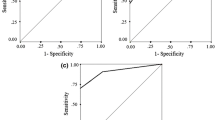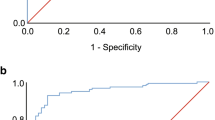Abstract
Purpose
The SD-101 is a non-restrictive sheet-like medical device that measures sleep-disordered breathing using pressure sensors that can detect the gravitational alterations in the body that accompany respiratory movement. One report has described that the screening specificity of the SD-101 for mild to moderate obstructive sleep apnea syndrome (OSAS) is relatively low. The present study examines whether the accuracy of the SD-101 for OSAS screening is improved by simultaneously measuring percutaneous oxygen saturation (SpO2).
Methods
Sixty consecutive individuals with suspected OSAS consented to undergo overnight polysomnography (PSG) together with simultaneous measurements of SD-101 and SpO2 at our laboratory.
Results
The apnea–hypopnea index (AHI) determined from PSG and the respiratory disturbance index determined from SD-101 measurements significantly correlated (SD-101 alone: r = 0.871, p < 0.0001; SD-101 with SpO2: r = 0.965, p < 0.0001). Bland–Altman plots showed a smaller dispersion for the SD-101 with SpO2 than for the SD-101 alone. The SD-101 with SpO2 detected an AHI of >15 on PSG with a sensitivity and specificity of 96.9 and 90.5 % compared with 87.5 and of 85.7 %, respectively, of the SD-101 alone.
Conclusions
Simultaneously measuring SpO2 improved the accuracy of the SD-101 for OSAS screening. Furthermore, this modality appears to offer high sensitivity and specificity for detecting even moderately severe OSAS.




Similar content being viewed by others
References
Young T, Palta M, Dempsey J, Weber S, Badr S (1993) The occurrence of sleep-disordered breathing among middle-aged adults. N Engl J Med 328:1230–1235
Baldwin CM, Kapur VK, Holberg CJ, Rosen C, Niteto FJ, Sleep Heart Health Study Group (2004) Associations between gender and measures of daytime somnolence in the Sleep Heart Health Study. Sleep 27:305–311
Neruntarat C, Chantapant S (2011) Prevalence of sleep apnea in HRH Princess Maha Chakri Srinthorn Medical Center, Thailand. Sleep Breath 15:641–648
Nakayama-Ashida Y, Takegami M, Chin K, Sumi K, Nakamura T, Takahashi K, Wakamura T, Horita S, Oka Y, Minami I, Fukuhara S, Kadotani H (2008) Sleep-disordered breathing in the usual lifestyle setting as detected with home monitoring in a population of working men in Japan. Sleep 31:419–425
Nieto FJ, Young TB, Lind BK, Shahar E, Samet JM, Redline S, D’Agostino RB, Newman AB, Lebowitz MD, Pickering TG (2000) Association of sleep-disordered breathing, sleep apnea, and hypertension in a large community-based study. Sleep Heart Health Study. JAMA 283:1829–1836
Hasan A, Uzma N, Swamy TL, Shoba A, Kumar BS (2012) Correlation of clinical profiles with obstructive sleep apnea and metabolic syndrome. Sleep Breath 16:111–116
Mehra R, Benjamin EJ, Shahar E, Gottlieb DJ, Nawabit R, Kirchner HL, Sahadevan J, Redline S (2006) Association of nocturnal arrhythmias with sleep-disordered breathing: The Sleep Heart Health Study. Am J Respir Crit Care Med 173:910–916
McNicholas WT, Bonsigore MR (2007) Sleep apnea as an independent risk factor for cardiovascular disease: current evidence, basic mechanisms and research priorities. Eur Respir J 29:156–178
Joo BE, Sek HY, Yu SW, Kim BJ, Park KW, Lee DH, Jung KY (2011) Prevalence of sleep-disordered breathing in acute ischemic stroke as determining using a portable sleep apnea monitoring device in Korean subjects. Sleep Breath 15:77–82
Somers VK, White DP, Amin R, Abraham WT, Costa F, Culebras A, Daniels S, Floras JS, Hunt CE, Olson LJ, Pickering TG, Russell R, Woo M, Young T (2008) Sleep apnea and cardiovascular disease: an American Heart Association/American College of Cardiology Foundation Scientific Statement from the American Heart Association Council for High Blood Pressure Research Professional Education Committee, Council on Clinical Cardiology, Stroke Council, and Council on Cardiovascular Nursing. In collaboration with the National Heart, Lung, and Blood Institute National Center on Sleep Disorders Research (National Institutes of Health). Circulation 118:1080–1111
Agatsuma T, Fujimoto K, Komatsu Y, Urushihata K, Honda T, Tsukahara T, Nomiyama T (2009) A novel device (SD-101) with high accuracy for screening sleep apnoea–hypopnea syndrome. Respirology 14:1143–1150
Alihanka J, Vaahtoranta K, Saarikivi I (1981) A new method for long-term monitoring of the ballistocardiogram, heart rate, and respiration. Am J Physiol 240:384–392
Takasaki Y, Kaneko Y, Sakakibara H, Sasaki F, Uchiyama Y, Murata A, Kudo S (2008) Clinical usefulness and health-economic benefits a new sheet-like medical device (SD-101) for the diagnosis of sleep apnea syndrome. Nihon Kokyuki Gakkai Zasshi 46:181–188
Rechtchaffen A, Kales A (1968) A manual of standardized terminology, techniques and scoring system for sleep stages of human subjects. Brain Information Service, Brain Research Institute, Los Angeles
ASDA (1992) EEG arousal: scoring rules and examples: a preliminary report from the Sleep Disorders Atlas Task Force of the American Sleep Disorders Association. Sleep 15:173–184
The Report of an American Academy of Sleep Medicine Task Force (1999) Sleep-related breathing disorders in adults: recommendations for syndrome definition and measurement techniques in clinical research. Sleep 22:667–689
Nishida Y, Takeda M, Mori T, Mizoguchi H, Sato T (1998) Unrestrained and non-invasive monitoring of human’s respiration and posture in sleep using pressure sensors. JRSJ 5:705–711
Bland JM, Altman DG (1986) Statistical methods for assessing agreement between two methods of clinical measurement. Lancet 1:307–310
Christ-Crain M, Stolz D, Jutla S, Couppis O, Muller C, Bingisser R, Schuetz M, Edwards R, Muller B, Grossman AB (2007) Free and total cortisol levels as predictors of severity and outcome in community-acquired pneumonia. Am J Crit Care Med 176:913–920
Dingli K, Coleman EL, Vennelle M, Finch SP, Wraith PK, Mackay TW, Douglas NJ (2003) Evaluation of a portable device for diagnosing the sleep apnoea/hypopnoea syndrome. Eur Respir J 21:253–259
Levendowski D, Steward D, Woodson BT, Olmstead R, Popovic D, Westbrook P (2009) The impact of sleep apnea variability measured in-lab versus in-home on sample size calculations. In Arch Med 2:2
Le Bon O, Hoffmann G, Tecco J, Staner L, Noseda A, Pelc I, Linkowski P (2000) Mild to moderate sleep respiratory events: one negative night may not be enough. Chest 118:353–359
Meyer TJ, Eveloff SE, Kline LR, Millman RP (1993) One negative polysomnogram does not exclude obstructive sleep apnea. Chest 103:756–760
Raj R, Hirshkowitz M (2003) Effect of the new Medicare guideline on patient qualification for positive airway pressure therapy. Sleep Med 4:29–33
Reichert JA, Bloch DA, Cundiff E, Votteri BA (2003) Comparison of the NovaSom QSG, a new sleep apnea home-diagnostic system, and polysomnography. Sleep Med 4:213–218
Candela A, Hernandez L, Asensio S, Sanchez-Paya J, Vila J, Benito N, Romero S (2005) Validation of a respiratory polygraphy system in the diagnosis of sleep apnea syndrome. Arch Bronconeumol 41:71–77
Yin M, Miyazaki S, Itasaka Y, Shibata Y, Abe T, Miyoshi A, Ishikawa K, Togawa K (2005) A preliminary study on application of portable monitoring for diagnosis of obstructive sleep apnea. Auris Nasus Larynx 32:151–156
Flemons WW, Littner MR, Rowley JA, Gay P, Anderson WM, Hudgel DW, McEvoy RD, Dl L (2003) Home diagnosis of sleep apnea: a systematic review of the literature. An evidence review cosponsored by the American Academy of Sleep Medicine, the American College of Chest Physicians, and the American Thoracic Society. Chest 124:1543–1579
Tonelli de Oliveira AC, Martinez D, Vasconcelos LF, Goncalves SC, Lenz MC, Fuchs SC, Gus M, Abreu-Silva EO, Moreira LB, Fuchs FD (2009) Diagnosis of obstructive sleep apnea syndrome and its outcomes with home portable monitoring. Chest 135:330–336
Santos-Silva R, Sartori DE, Truksinas V, Truksinas E, Alonoso FF, Tufik S, Bittencourt LR (2009) Validation of a portable monitoring system for the diagnosis of obstructive sleep apnea syndrome. Sleep 32:629–636
Bar A, Pillar G, Dvir I, Sheffy J, Schnall RP, Lavie P (2003) Evaluation of a portable device based on peripheral arterial tone for unattended home sleep studies. Chest 123:695–703
Overland B, Bruskeland G, Akre H, Skatvedt O (2005) Evaluation of a portable recording device (Reggie) with actimeter and nasopharyngeal/esophagus catheter incorporated. Respir 72:600–605
Acknowledgments
This study was supported by a Health Science Research Grant (no. 22111201: Comprehensive Research on Life-Style Related Diseases including Cardiovascular Diseases and Diabetes Mellitus) from the Ministry of Health, Labor and Welfare of Japan.
Author information
Authors and Affiliations
Corresponding author
Rights and permissions
About this article
Cite this article
Kobayashi, M., Namba, K., Tsuiki, S. et al. Validity of sheet-type portable monitoring device for screening obstructive sleep apnea syndrome. Sleep Breath 17, 589–595 (2013). https://doi.org/10.1007/s11325-012-0725-z
Received:
Revised:
Accepted:
Published:
Issue Date:
DOI: https://doi.org/10.1007/s11325-012-0725-z




